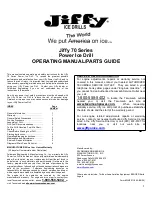
4
ENGLISH
e. Maintain power tools. Check for misalignment or
binding of moving parts, breakage of parts and any
other condition that may affect the power tools
operation. If damaged, have the power tool repaired
before use.
Many accidents are caused by poorly maintained power tools.
f. Keep cutting tools sharp and clean.
Properly maintained cutting tools with sharp cutting
edges are less likely to bind and are easier to control.
g. Use the power tool, accessories and tool bits etc., in
accordance with these instructions and in the
manner intended for the particular type of power
tool, taking into account the working conditions and
the work to be performed.
Use of the power tool for operations different from those
intended could result in a hazardous situation.
5. Battery tool use and care
a. Ensure the switch is in the off position before
inserting battery pack.
Inserting the battery pack into power tools that have the
switch on invites accidents.
b. Recharge only with the charger specified by the
manufacturer.
A charger that is suitable for one type of battery pack may
create a risk of fire when used with another battery pack.
c. Use power tools only with specifically designated
battery packs.
Use of any other battery packs may create a risk of injury
and fire.
d. When battery pack is not in use, keep it away from
other metal objects like paper clips, coins, keys,
nails, screws, or other small metal objects that can
make a connection from one terminal to another.
Shorting the battery terminals together may cause burns
or a fire.
e. Under abusive conditions, liquid may be ejected
from the battery; avoid contact. If contact
accidentally occurs, flush with water. If liquid
contacts eyes, additionally seek medical help.
Liquid ejected from the battery may cause irritation or burns.
6. Service
a. Have your power tool serviced by a qualified repair
person using only identical replacement parts.
This will ensure that the safety of the power tool is maintained.
Additional safety instructions for drill/screwdrivers
Before drilling into walls, floors or ceilings, check for the
location of wiring and pipes.
Avoid touching the tip of a drill bit just after drilling, as it
may be hot.
Additional safety instructions for batteries and chargers
Batteries
Never attempt to open for any reason.
Do not expose the battery to water.
Do not expose the battery to heat.
Do not store in locations where the temperature may
exceed 40 °C.
Charge only at ambient temperatures between 10 °C and
40 °C.
Charge only using the charger provided with the tool.
When disposing of batteries, follow the instructions given
in the section “Protecting the environment”.
Chargers
Use your Black & Decker charger only to charge the
battery in the tool with which it was supplied. Other
batteries could burst, causing personal injury and
damage.
Never attempt to charge non-rechargeable batteries.
Have defective cords replaced immediately.
Do not expose the charger to water.
Do not open the charger.
Do not probe the charger.
The charger is intended for indoor use only.
Read the instruction manual before use.
The charger automatically shuts off if the ambient
temperature becomes too high. As soon as the
ambient temperature has cooled down, the charger
will resume operating.
Charge only at ambient temperatures between 10 °C
and 40 °C.
Charging
Electrical safety
Your charger is double insulated; therefore no earth
wire is required. Always check that the mains
voltage corresponds to the voltage on the rating
plate. Never attempt to replace the charger unit with
a regular mains plug.
This appliance is not intended for use by young or infirm
persons without supervision. Children must be supervised
to ensure they do not play with the appliance.





































